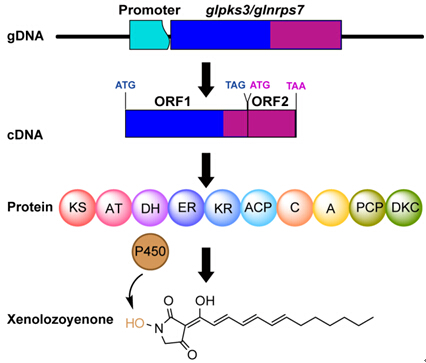In genetics, an operon is a functioning unit of genomic DNA containing a cluster of genes under the control of a single promoter. Originally, operons were thought to exist solely in prokaryotes, while clustered protein-coding genes with coexpression behave as operons have been detected in some animals and plant recently, such as Caenorhabditis elegans, flies, and tomato. However, operons in Fungi, a Kingdom of Organism, have not been reported.
Cooperative research between Prof. Xingzhong Liu's group in CAS Institute of Microbiology and Prof. Zhiqiang An's group in the University of Texas Health Science Center at Houston discovered a functional operon involved in the secondary metabolism of the fungus Glarea lozoyensis belonging to Leotiomycetes (Ascomycota). Two contiguous genes glpks3 and glnrps7 encoding polyketide synthase and nonribosomal peptide synthetase, respectively, are co-transcribed into one dicistronic mRNA under the control of the same promoter, and the mRNA is then translated into two individual proteins GLPKS3 and GLNRPS7. Heterologous expression in Aspergillus nidulans shows that the GLPKS3/GLNRPS7 enzyme complex catalyzes the biosynthesis of a novel tetramic acid-containing compound, xenolozoyenone, which indicates the operon is functional. Although structurally similar to prokaryotic operons, the glpks3/glnrps7 operon locus has monophylogenic origin from fungi rather than horizontally transferred from prokaryotes. Moreover, two additional operons glpks28/glnrps8 and glpks29/glnrps9 were verified at the transcriptional level in the same fungus. In addition, operon-like structures have been predicted in silico to be common in other fungi. This is the first report of protein-coding operons in the Fungi. The identification of operons in the Fungi not only reveals the complexity of gene transcription and regulation in eukaryotic organisms, but also facilitates future studies concerning the origin and evolution of fungal genes that encode antibiotics and other secondary metabolites.

The results were published in the mBio. Profs. Liu and An are the co-corresponding authors. This work was supported by grants from the National Science Foundation of China and University of Texas.
GLPKS3/GLNRPS7 operon gene organization in Glarea lozoyensis and its product xenolozoyenone biosynthesized in the heterologous host Aspergillus nidulans.